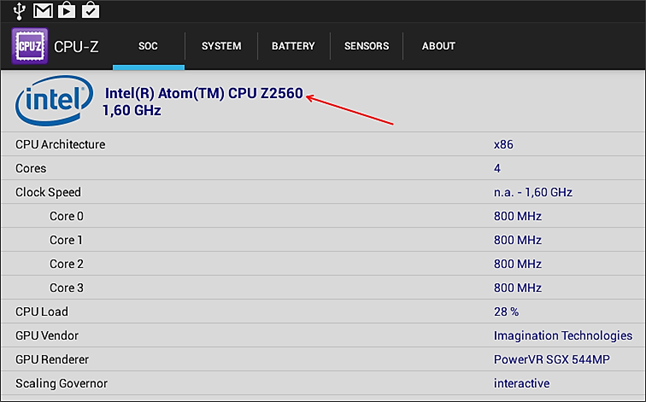Sometimes to be sure the game will work on your device in addition to Android version you need to know detailed information about your central processing unit (CPU) and graphical processing unit (GPU)
To find out detailed information about your device you can download a free app called CPU-Z (DOWNLOAD)

CPU-Z is an Android version of a popular program that identifies your processor. CPU-Z lets you know what processing unit you have on your Android device. Besides that you can use it to find out all the characteristics of the processor and other technical info about your device.
CPU-Z has several tabs:
- SOC – information about the processing unit on your Android device. There’s info about your processor, architecture (x86 or ARM), number of cores, clock speed, and GPU model.
- System – info about the modelf your Android device, manufacturer, and Android version. There are also some technical info about your Android device like screen resolution, pixel density, RAM and ROM.
- Battery – information about battery. Here you can find battery’s state of charge, voltage, and temperature.
- Sensors – information that comes from the sensors on your Android device. The data changes in real time.
- About – the info about the installed app.
As you run the app you’ll get the message that offers you to save the settings. Tap Save. After that CPU-Z will open at SOC tab.

Here at the very top you’ll see processor model of your Android device and under it there’ll be its technical characteristics.
A bit lower you can see you GPU characteristics.
NOTE: Make sure your device meets game requirements before complaining that the game doesn’t work
There are some games on our website that require the ARMv6 or ARMv7 device.
Thus, ARM architecture is a family of RISC-based computer processors.
ARM periodically releases updates to its core — currently ARMv7 and ARMv8 — which chip manufacturers can then license and use for their own devices. Variants are available for each of these to include or exclude optional capabilities.
Current versions use 32-bit instructions with 32-bit address space, but accommodates 16-bit instructions for economy and can also handle Java bytecodes which use 32-bit addresses. More recently, ARM architecture has included 64-bit versions — in 2012, and AMD announced that it would start producing server chips based on the 64-bit ARM core in 2014.
ARM cores
|
Architecture |
Family |
|
ARMv1 |
ARM1 |
|
ARMv2 |
ARM2, ARM3, Amber |
|
ARMv3 |
ARM6, ARM7 |
|
ARMv4 |
StrongARM, ARM7TDMI, ARM8, ARM9TDMI, FA526 |
|
ARMv5 |
ARM7EJ, ARM9E, ARM10E, XScale, FA626TE, Feroceon, PJ1/Mohawk |
|
ARMv6 |
ARM11 |
|
ARMv6-M |
ARM Cortex-M0, ARM Cortex-M0+, ARM Cortex-M1 |
|
ARMv7 |
ARM Cortex-A5, ARM Cortex-A7, ARM Cortex-A8, ARM Cortex-A9, ARM Cortex-A15, ARM Cortex-R4, ARM Cortex-R5, ARM Cortex-R7, Scorpion, Krait, PJ4/Sheeva, Swift |
|
ARMv7-M |
ARM Cortex-M3, ARM Cortex-M4 |
|
ARMv8-A |
ARM Cortex-A53, ARM Cortex-A57, X-Gene |
The most popular GPU on Android devices
Tegra, developed by Nvidia, is a system-on-a-chip series for mobile devices such as smartphones, personal digital assistants, and mobile Internet devices. The Tegra integrates the ARM architecture processor central processing unit (CPU), graphics processing unit (GPU), northbridge, southbridge, and memory controller onto one package. The series emphasizes low power consumption and high performance for playing audio and video.
PowerVR is a division of Imagination Technologies (formerly VideoLogic) that develops hardware and software for 2D and 3D rendering, and for video encoding, decoding, associated image processing and Direct X, OpenGL ES, OpenVG, and OpenCL acceleration.
Snapdragon is a family of mobile system on chips by Qualcomm. Qualcomm considers Snapdragon a "platform" for use in smartphones, tablets, and smartbook devices. The Snapdragon application processor core, dubbed Scorpion, is Qualcomm's own design. It has many features similar to those of the ARM Cortex-A8 core and it is based on the ARM v7 instruction set, but theoretically has much higher performance for multimedia-related SIMD operations.
The Mali series of graphics processing units (GPUs) produced by ARM Holdings for licensing in various ASIC designs by ARM partners. Like other embedded IP cores for 3D support, the Mali GPU does not feature display controllers driving monitors. Instead it is a pure 3D engine that renders graphics into memory and hands the rendered image over to another core that handles the display.



